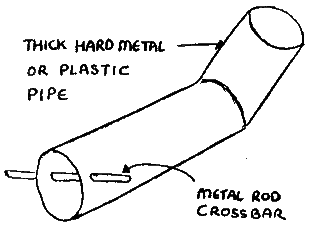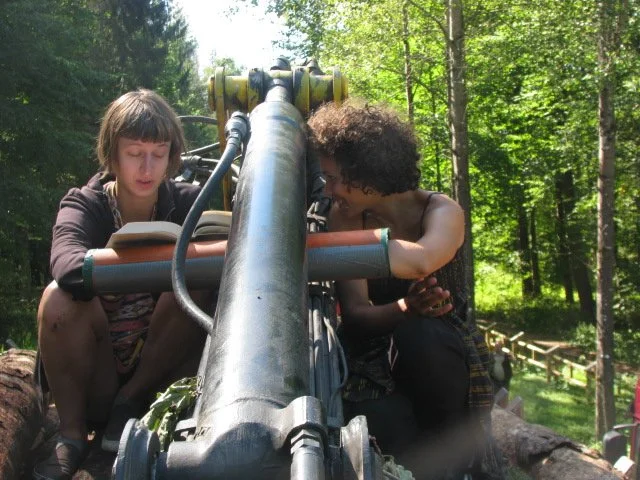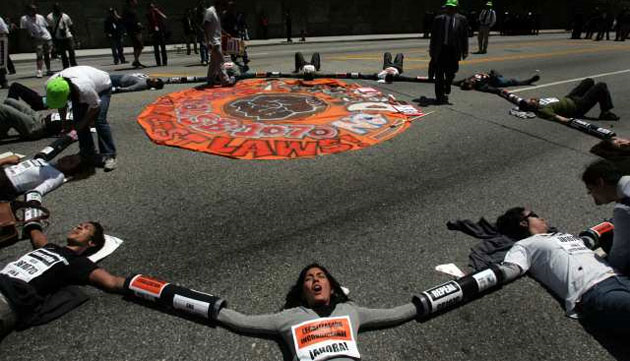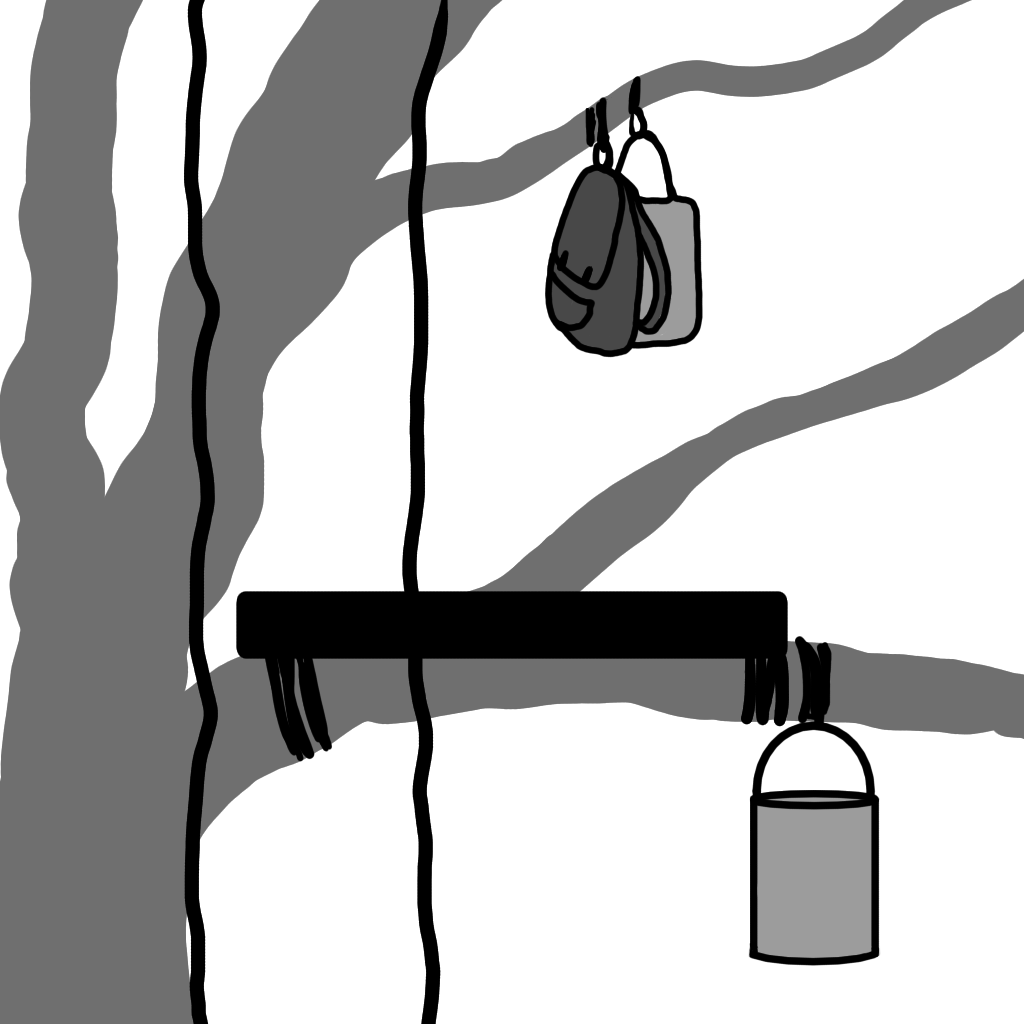Lock-on’s, devices, tree-sits and more
(Device) Thumb cuffs are commonly used to make it even more difficult for an activist to be removed from a lock-on. They can be used alone; with arms around a fence or similar object, or they can be used inside of the ‘elbow’ pictured later, in place of the carabiners that are pictured in the diagram. They should be tight enough that they cannot be pulled or worked off by police. They will pull very hard and may use oil or other things to loosen the cuffs. Thumb-cuffs can often be found at army supply shops.
Guards for Lock-on’s - Straight pieces of PVC pipe make great guards for the device chosen for use. Pictured is a PVC pipe with a wooden or metal dowel (drilled) through the middle to connect the device to. Carabiners with rope are pictured. Activists put their wrist through either loop at the end. Activists can also use two carabiners to lock-on. This ‘pattern’ or method can be repeated as many times as is necessary to accommodate as many activists that want to lock-on. AG’s can make a straight line (blockade) or a circle etc. This method works well when folks don’t have a lot of time to prepare.
This is an elbow. It can be made from plastic, but metal is a better material to use if folks have the tools to do that. For one or two people. It is like the first pipe pictured above, with a dowel through the middle to connect to. Thumb-cuffs can be used instead of carabiners.
Lock-on’s - This is a barrel. AG’s can use any larger, round and hollow item to make a barrel, but an actual barrel is the best item to use, hence the name. The same PVP pipe from before is being used through the middle of the barrel and it is surrounded by concrete. It is best to use quick-set cement, and AG’s can also fill it with metal and/or plastic bits of crates or other objects to make cutting through it even more difficult. There would be an activist at both ends of the barrel. For the diagram on the left, imagine the barrel has been cut in half.
This is a dragon. It may be referred to by different names, but the idea is the same. It is like the inside of a barrel, and it is entirely underground aside from the very top where an activist will place their arm through to lock on. That means the activist will be laying down on the ground most likely, once locked on. The dowel is at the end of the pipe instead of the middle like the other examples. The most common method is to construct the dragon on site, pouring the quick-set cement straight in to a hole that you have dug. These are commonly used during forest blockades at the base of large trees; making sure to not damage root systems. Same as before; imagine the dragon is cut in half. The black line at the top is ‘ground level’. Measure the pipes to make sure they won’t be covered with cement, whether making a dragon or barrel. If making a dragon, make sure the hole is deep enough for the full length of an arm to fit. AG’s can choose to go in halfway instead, but this makes it easier to remove the activist. Make sure the activist wraps arm(s) in rags or something else that will fill up any extra space in the pipe so that police cannot see how they are locked on, and so they cannot get their hands or any tools down the pipe to remove their arm from the lock-on.
Tree-sits
Tree-sitting is a form of environmentalist civil disobedience in which a protester sits in a tree for what is often an extended period of time, usually on a small platform built for the purpose, to protect it from being cut down (speculating that loggers will not endanger human lives by cutting an occupied tree). Supporters usually provide the tree-sitters with food and other supplies. This may have to be done through covert methods if the area of tree-sit is fenced off or otherwise guarded. Activists may also risk trespass charges in this situation so plan thoroughly.
Pictured is a basic tree sit. A wooden pallet, bed base or other type of platform is attached to a tree. A person then climbs onto the platform and typically remains there either until there is no longer a need to stay, or they are removed by force. Not all trees are suitable for supporting a sit as it must have appropriate branches capable of bearing the weight of the platform, the sitter and their supplies. Usually at least two thick and sturdy branches are needed to support the platform, however a rigger with experience may be able to improvise and create additional supports where appropriate branches can't be found. This can sometimes be done by fully or partially suspending the platform, however this is done less often as a swinging platform can be unsettling for the sitter. In some cases, a platform is suspended from a single rope known as a "god-line". This creates an additional barrier for workers/police, as if the god-line is interfered with the platform can drop, taking the sitter with it. Sometimes the god-line is attached to surrounding trees, as this prevents the attached trees from being logged or bulldozed for fear of pulling down the sit. This can be done with fastened platforms as well as suspended ones.
Here is an amazing manual that will help potential climbers: Single Rope Technique - Climbing Gear: Use and Care
Setting up a sit:
Setting up a tree sit should only be attempted by someone who has climbing and rigging knowledge. Never attempt to rig or climb a tree sit without experience or the supervision of someone with experience. To set up a tree sit, AG’s/activists will need to first select a tree. Take into account it's position and height. Most cherry pickers extend less than 60m however they can be as tall as 100m. However, god-lines can be used to create a web that will prevent a cherry picker getting close enough to the tree to remove the sitter.
Once a tree is selected the tree-sitter will need:
1. A platform
2. Climbing grade rope for rigging (regular jute/nylon/cotton rope can be used for hanging supplies and fastening tarps, but isn't safe for climbing or rigging the platform)
3. Climbing equipment
The person setting up the sit will need to climb up and inspect the branches it will be attached to check their integrity. It's important to snap off any dead branches surrounding the sit otherwise the sitter may grab one for support or attempt to hang supplies from it and find it breaks. If the supporting branches are strong enough the rigger will attach the platform and god-lines if they're being used.
Who is the sitter?
A tree sit is a strenuous experience. A sitter must be in reasonably good health as they will essentially be in a survival situation with a finite amount of food, water, and medical supplies for an indefinite period. They must have received climbing training and be strong enough to climb up to the platform, and strong enough to lower and pull up their supplies.
The sitter will need some knowledge of knots, to allow them to hang their supplies and fasten their tarps. If the sit is likely to go on for more than a couple of days ideally the sitter will be able to climb down briefly at intervals to be checked out physically by their support crew for tick bites or signs of circulatory issues, and to walk around for a few minutes. Sometimes multiple sitters may rotate in shifts. However, this is not always possible and a sitter may be required to stay up the tree for long periods and in isolation. Sitters must be prepared for this.
Supplies:
This is only a basic list of suggestions. You really need to do your research and planning for things like tree-sits. There is a very real risk of injury and/or death. For professional training, check out your local forest alliance groups and other environmental groups that actively participate in blockades and other forms of direct action. They will most likely offer training or can point you in the right direction.
Expect to go through some form of vouching process if you are reaching out to others or groups regarding these types of skills and topics. You can probably find climbing/ropes training courses in your area through other means, too.
Depending on the situation the sitter may be able to climb into the sit and pull their supplies up on a rope. However, in stealth situations they may need to take their supplies up with them as they ascend, which will limit how much they can take up initially. A sitter climbing into a sit with only a backpack will need, at a minimum:
1. Water (enough for at least 24 hours)
2. Food (non-perishables such as crackers, tinned tuna, baked beans, nuts, protein bars etc. Multivitamins are often taken where rationing is required)
3. Tarp (for weather protection, it's usually fastened above the platform and closed aorund it tent-style)
4. Charged power-banks (portable chargers) for phone/devices (these can be rotated out by ground crew or solar chargers can be used)
5. First aid supplies (antiseptic, Band-Aids, tweezers for splinters, dressings, salve for bites/stings, etc.)
6. Sanitary supplies (Hand sanitizer, antibacterial wipes, toothbrush and toothpaste)
7. Walkie-talkie (extremely useful where phone reception is unreliable or as a backup in case phone can't be charged. Contact with ground crew is extremely important)
8. Batteries for walkie-talkies and any battery powered lights
9. Head torch or flash light (if you rely on your phone flash light you run the risk of dropping it)
10. Bag, bucket or container for rubbish (no waste is ideal but it's not always possible)
11. Toilet container(s) and toilet paper (the details are best worked out with the ground crew who will be disposing of this waste. It may involve rotating several smaller sealed containers or one large bucket with a lid. If bags are needed to dispose of waste, they should ideally be biodegradable)
12. Extra rope, bungee cords, snap-hooks/carabiners for hanging and fastening supplies
13. Safety equipment like a hard hat and any other protective clothing or accessories you may need
Many sitters will also take a lock-on device (see previous sections) into their sit so that in the event attempts are made to remove them by force, they can lock on the tree and prolong their removal.
Where the sitter can be easily accessed by ground crew and supplies are in abundance, the sit can be expanded greatly to accommodate a longer stay. Crates can be hung to store supplies, additional tarps added, banners hung, large water containers can be stored, even additional platforms or a camping shower added.
Supporting the sitter:
Ground crew is crucial to a tree sit and how long a sitter can handle staying up the tree will often come down to how well supported they are on the ground. Ground crew will need to maintain contact with the sitter, provide their supplies, dispose of their waste, assist them to problem solve and let them know what's happening on the ground. It is ideal if there are other climbers available as a visitor in a tree sit can be extremely helpful in combating the isolation. Ground crew need to monitor the wellbeing of the tree sitter and be prepared to arrange extraction in an emergency. Anxiety is common and sitters can become depressed. Communication and stimulation is extremely important in combating this. If entertainment such as music, movies, or games can be accommodated it can help greatly. Visitors and messages of support help morale. If access to the sitter is not an issue, sending up treats such as tea or a fresh hot meal can boost their spirits.
Aside from morale there are physical risks involved in occupying a tree sit. Tick bite, circulatory issues, vertigo. The sitter MUST move as often as possible, whether it's stationary walking, peddling, squats, lunges etc. Ground crew must check in with the sitter to ensure that they're getting enough movement to support circulation. Encourage the sitter to get up for a few minutes every half hour at least while they're awake. If the situation doesn't allow the sitter to descend for short intervals to be checked out by ground crew, the sitter must be inspecting their body daily to check for tick bites or varicose veins or any other sudden changes. Sometimes tree sitters will take blood thinners such as aspirin or turmeric to help support circulation.
Sitters often need the support of their ground crew to help them stay up in moments of stress and may need to talk their options through. However, if your tree sitter decides that they need to come down or becomes severely distressed, depressed or non-responsive, do not hesitate. Arrange their safe removal ASAP.
A tripod is a blockade device made by erecting 3 poles (usually either steel scaffolding or strong lengths of wood/tree branches) of equal length and securing them at the top to make a frame. A sitter is then either suspended from the top of the tripod or sat atop it on a platform. The frame then cannot simply be moved as it risks injury to the sitter. They usually must be removed either by cherry picker or by gradually cutting through the poles and lowering the structure in small increments until the sitter is low enough to be apprehended.
Tripods can be placed on roads to block traffic or machinery, or directly over machinery to prevent it being removed, as well as anywhere else there is level ground and enough space to erect it. God-lines can be used to attach the tripod to other objects such as trees or machinery or even other tripods in order to prolong the obstruction (see section on tree-sits for information about god-lines).
Tripod sitters will need to have received climbing training. They will need a short list of supplies including:
Supplies:
1. Water (camel packs are ideal)
2. Snacks
3. Phone/battery packs
4. Clothing appropriate for the weather (including sunscreen and hat if sunny, waterproofs if it's wet)
5. Most people will choose to wear an adult diaper as tripods can last for hours or even a day, possibly longer.
A variation on the tripod is a "monopole", which is similar but only uses one pole with a platform at the top. These are anchored at the bottom and almost always attached to something else via a god-line.
*Refer to list of supplies for tree-sits for more ideas of what to have with you*
More info on locKon’s And Tree-sits:
Single Rope Technique - Climbing Gear: Use and Care (Manual)
History as a Weapon - Locking Down with Lockboxes
Road Raging - Top Tips for Wrecking Roadbuilding, Chapter 12 - Tools for the Job
































